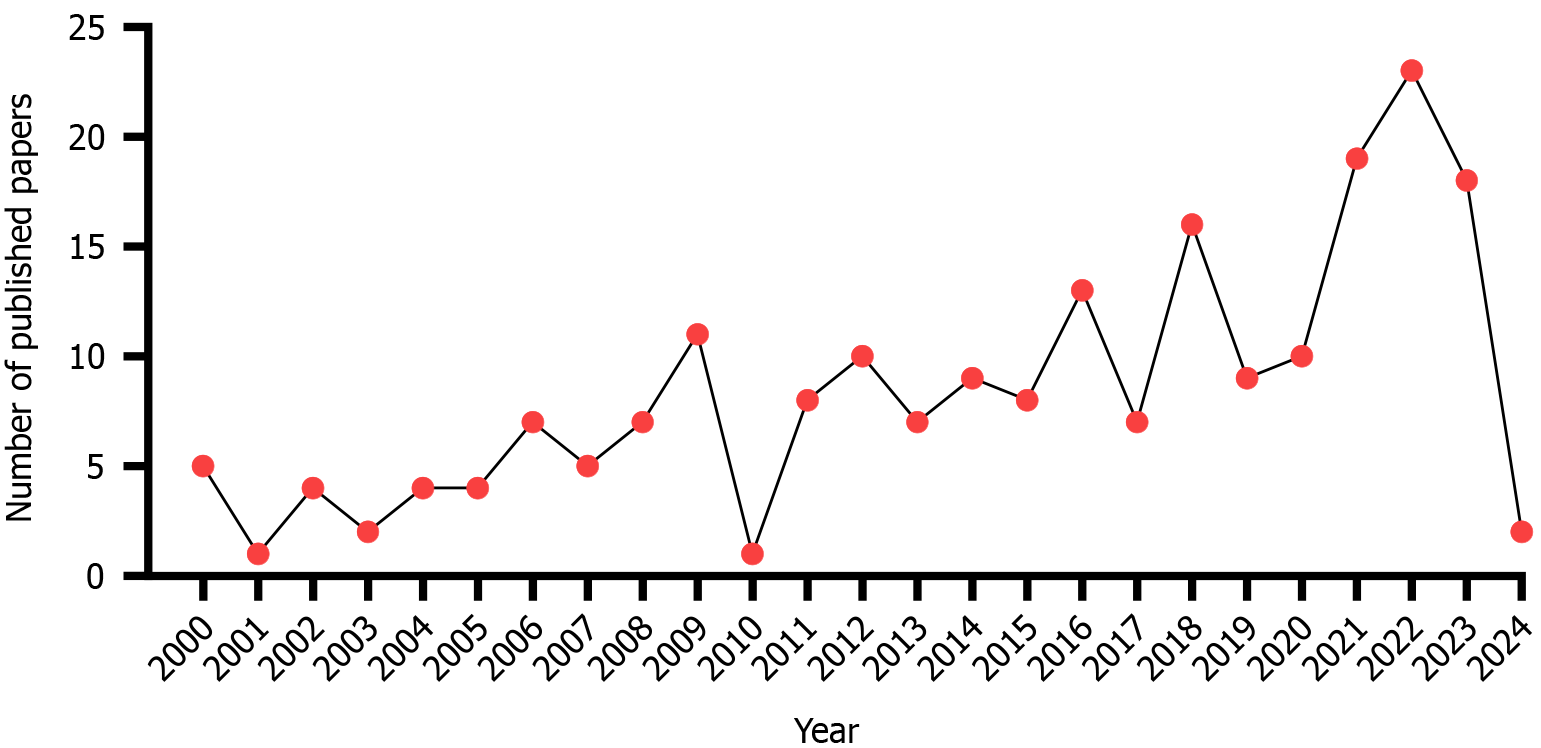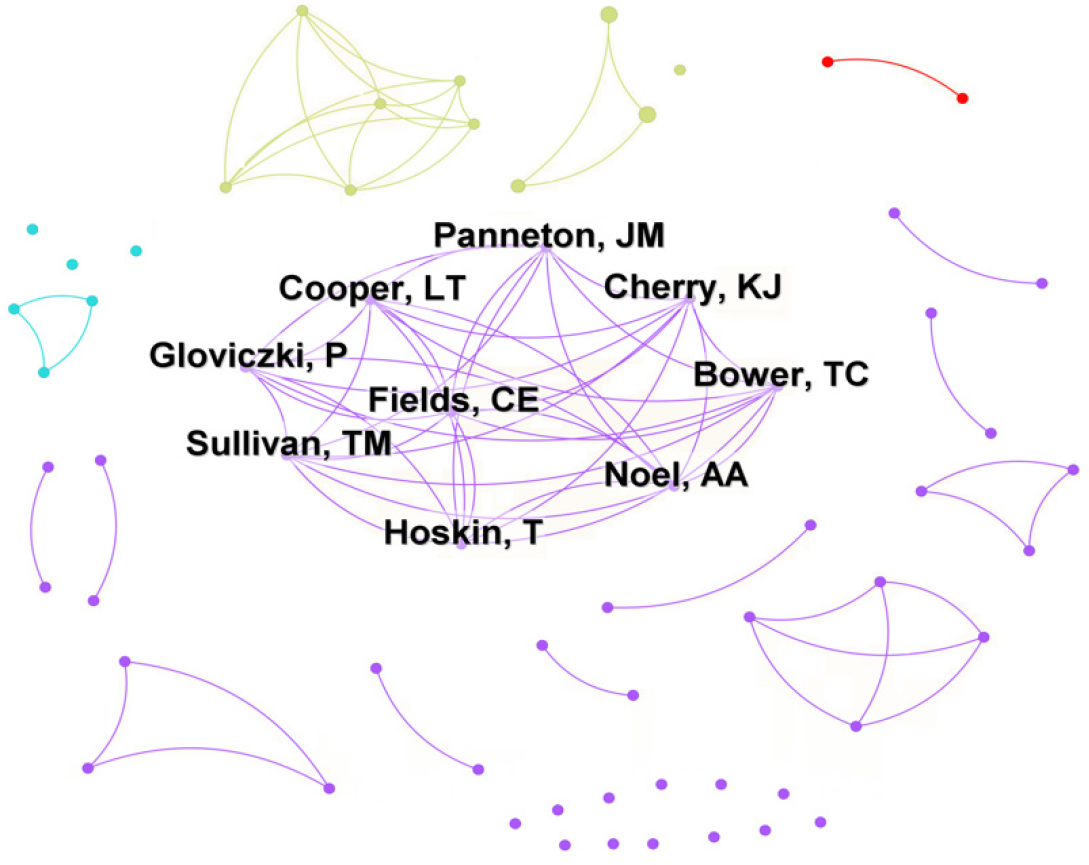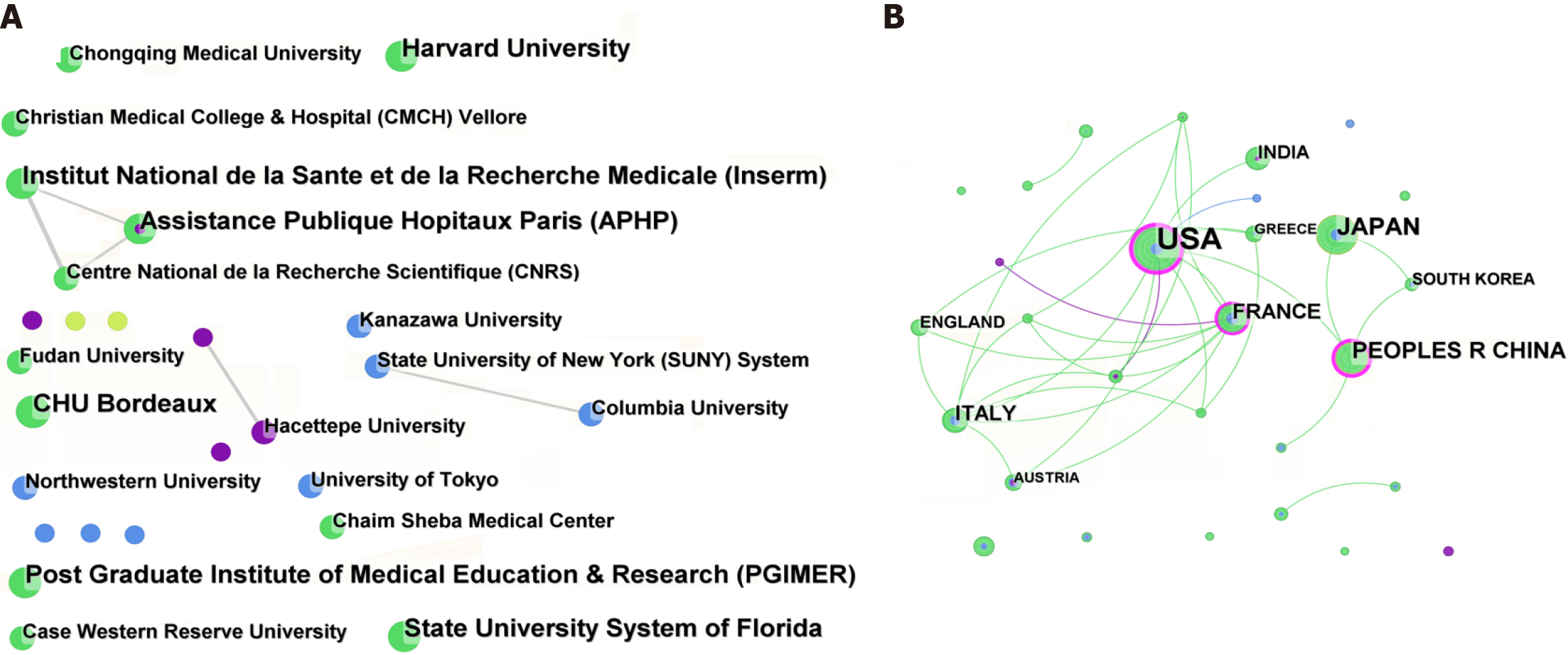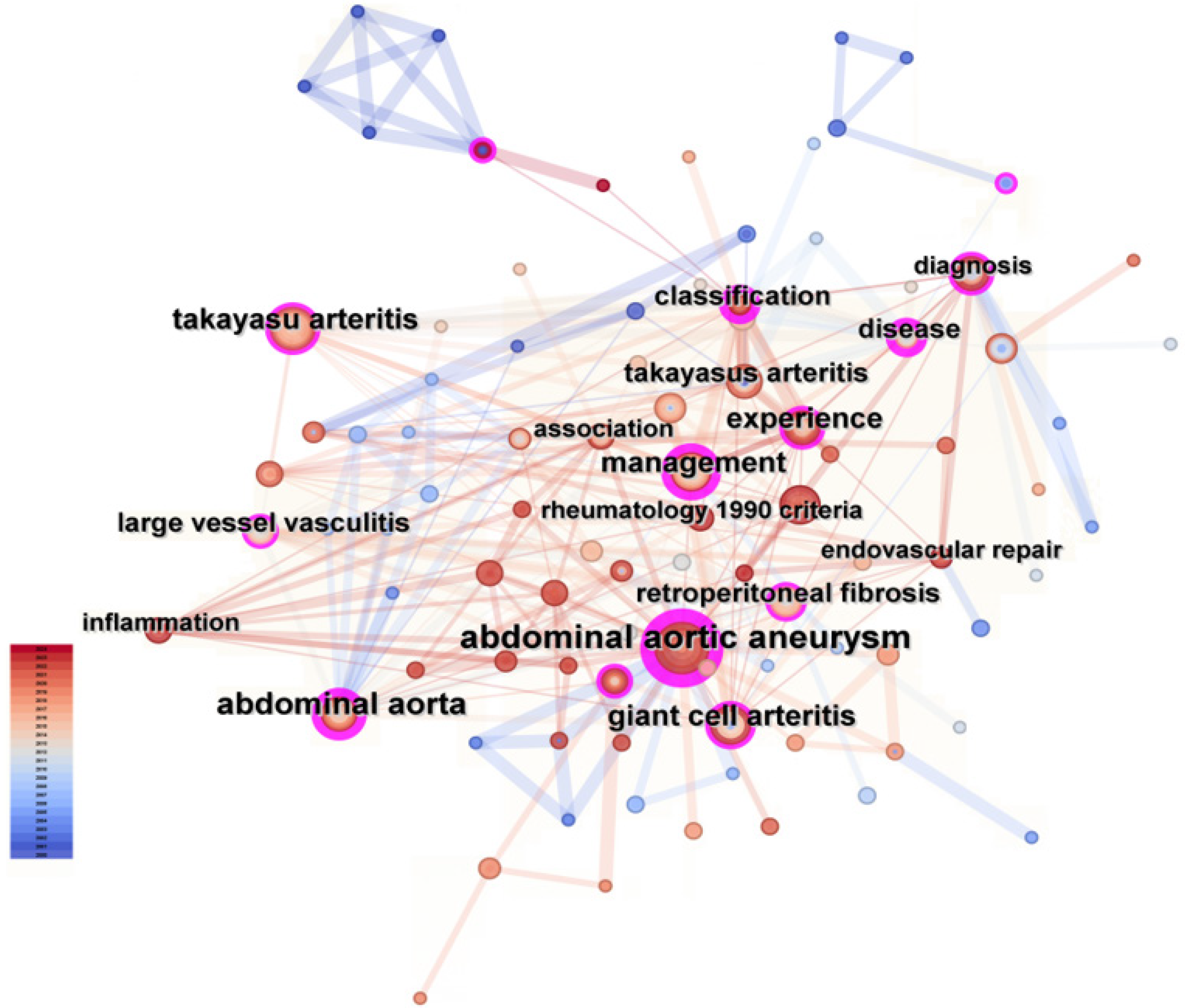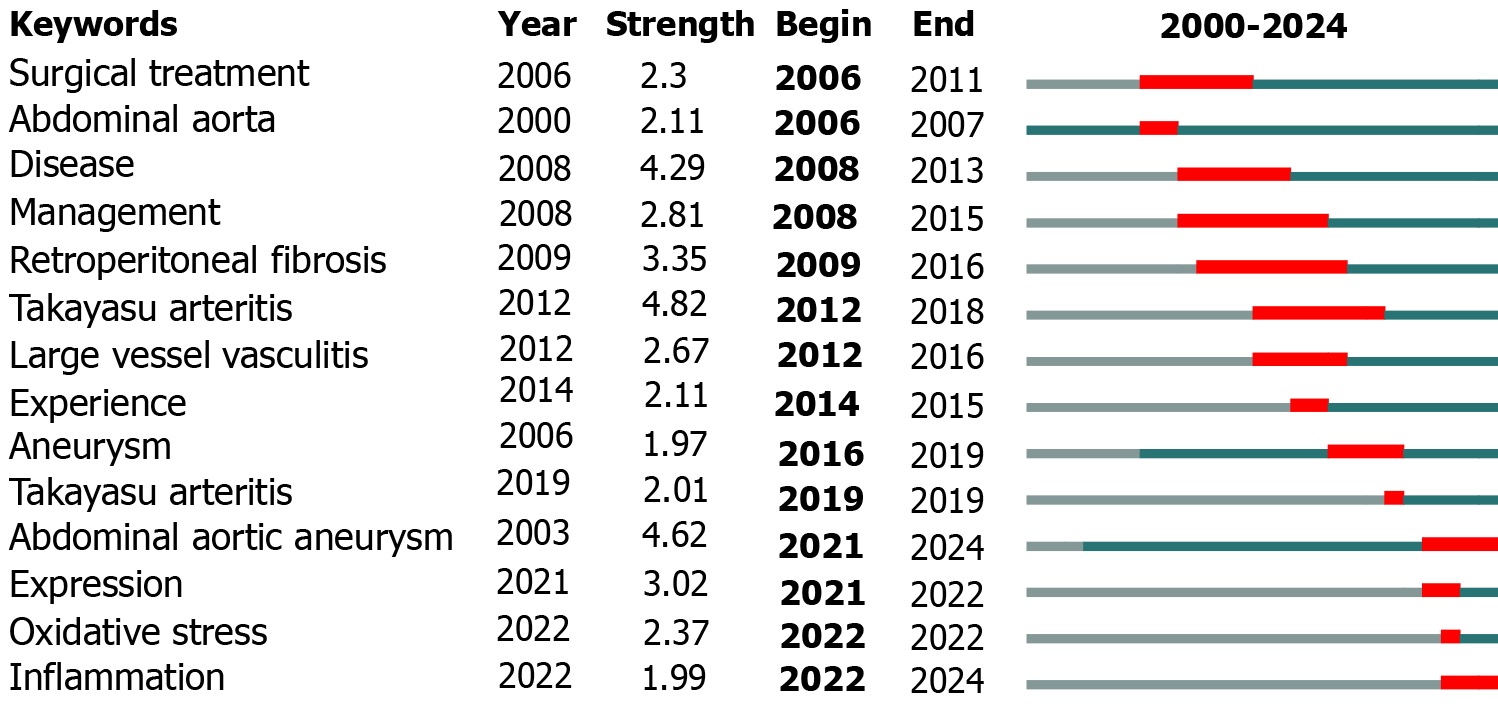Published online Jul 26, 2024. doi: 10.12998/wjcc.v12.i21.4717
Revised: May 11, 2024
Accepted: May 30, 2024
Published online: July 26, 2024
Processing time: 85 Days and 0.2 Hours
Abdominal aortitis can induce aneurysms, and tumor rupture can lead to organ ischemia or even sudden death. At present, there is a lack of extensive under
To discuss the research hotspot and development trend of abdominal aortitis treatment.
We searched the English literature (published from January 1, 2000 to March 12, 2024) on the treatment of abdominal aortitis in the Web of Science database. Then, we identified and screened duplicate literature using CiteSpace 6.1R2 software. We conducted an analysis of the number of papers, a co-occurrence analysis of the authors and institutions, and co-occurrence and cluster analyses of the keywords. Then, we drew the author, institution, and keywords of the studies into graphs for visualization. Finally, we expounded on the author, institutional network interactions, and hot keywords of the studies on the treatment of abdominal aortitis.
We included 210 English literature articles involving 190 authors; the author cooperation team was mainly represented by Caradu Caroline, Berard Xavier, Lu Guanyi, Harada Kenichi, and Sharma Ashish K. In the keyword analysis, high-frequency keywords include abdominal aortic aneurysm (38), abdominal aorta (24), Takayasu arteritis (22), etc. The three most central keywords were disease (0.69), classification (0.68), and abdominal aortic aneurysm (0.55). The first nine clusters of keywords are case report, abdominal aortic aneurysm, Takayasu arteritis, dyspnea hematuria, aortic elastic, IgG4-related disease, report, mid aortic dysplastic syndrome, and statin. In the keyword emergent analysis, 14 emergent words were obtained. Among them, seven keywords with strong abruptness were Takayasu arteritis, abdominal aortic aneurysm, disease, retroperitoneal fibrosis, expression, management, and large vessel vasculitis. In the past 3 years, the incidences of abdominal aortic aneurysm (intensity: 4.62) and inflammation (intensity: 1.99) were higher.
The number of published papers is on the increase, but the cooperation among authors is scattered. The research focus is mainly on the pathogenesis and treatment of abdominal aortitis-related diseases.
Core Tip: Aortitis is a chronic inflammatory condition that can cause serious illness and even death if left untreated. A CiteSpace bibliometric analysis of the treatment of abdominal aortitis clarified the key issues in the treatment of abdominal aortitis and the network connections between treatments, authors, institutions, countries, and keywords.
- Citation: Guo SE, Meng YB, Zhang ZM, Zhang YL, Yao QS, Qin X. Visual analysis of abdominal aortitis treatment using the CiteSpace bibliometric method. World J Clin Cases 2024; 12(21): 4717-4725
- URL: https://www.wjgnet.com/2307-8960/full/v12/i21/4717.htm
- DOI: https://dx.doi.org/10.12998/wjcc.v12.i21.4717
Inflammatory lesions of the great artery endothelium include morphological changes of the artery endothelium and the expression of inflammatory molecules that directly affect the pathological evolution of the disease. Abdominal aortitis is a chronic non-specific inflammatory disease characterized by abdominal pain, abdominal throb pain, abdominal muscle tension, fever, nausea, and vomiting[1]. The etiology of abdominal aortitis is unclear but may be related to the destruction of the middle layer of the aortic wall and structural changes of the vascular wall caused by genetics, hypertension, chronic inflammation, and other factors[2]. If not treated properly or in time, abdominal aortitis can induce aneurysms[3], and the resulting rupture of aneurysms can lead to organ ischemia, which is the third cause of sudden death after myocardial infarction and stroke[4]. Recent studies demonstrated that glucocorticoids (prednisone and methylprednisolone), immunosuppressants (azathioprine and cyclophosphamide), and surgery (such as aortic artificial vascular replacement) have significant effects on the treatment of abdominal aortitis[5].
Bibliometric analyses use statistical methods and visualization to explore the structure and trends of a discipline or field[6]. Compared with traditional reviews, bibliometric analyses, which have been gradually applied to medical-related fields, can quickly identify key issues in a field[7,8]. However, this method has not been applied to the treatment of abdominal aortitis. Thus, a bibliometric analysis was conducted with relevant research literature included in the Web of Science (WOS) database as the research object, and the results were visualized using CiteSpaceV software. This analysis can improve our understanding of the content and hot topics of current research on the treatment of abdominal aortitis and provide a reference for future research.
Data for this study came from the WOS database from January 1965 to March 12, 2024. The database search retrieved 317 pieces of English literature, including 210 pieces published from January 1, 2000 to March 12, 2024 (Table 1).
| Serial number | Number of publications | Year | Author |
| 1 | 3 | 2023 | Caradu Caroline |
| 2 | 3 | 2023 | Berard Xavier |
| 3 | 2 | 2018 | Lu Guanyi |
| 4 | 2 | 2009 | Harada Kenichi |
| 5 | 2 | 2018 | Sharma Ashish K |
| 6 | 2 | 2008 | Rodriguez Heron E |
| 7 | 2 | 2023 | Ducasse Eric |
| 8 | 2 | 2018 | Spinosa Michael D |
| 9 | 2 | 2016 | Fu Weiguo |
| 10 | 2 | 2018 | Su Gang |
CiteSpaceV software was applied to visually analyze the research content and hotspots. CiteSpace is a Java-based application for analyzing and visualizing trends and patterns in the scientific literature for complex, long-term, diverse data. The software can visually present various data in a certain research field, including research results, research institutions, researchers, and keywords[9]. The main research indicators for this analysis included the number of publications, authors, institutions, countries, and keywords.
Between January 1, 2000 and March 12, 2024, 210 English literature publications were identified, with an average annual publication volume of 8.4 ± 5.6. The lowest publication rate was 1 in 2001 and 2010. The largest number of articles was 23 in 2022. The distribution of published papers shows that research in the field of abdominal aortitis is increasing. The number of papers decreased in 2019 compared with 2018, but the number of published documents began to increase in 2020. The data was retrieved up until March 12, 2024; thus, the data for 2024 are incomplete (Figure 1).
The author distribution map has 190 nodes, each representing a different author, and 445 lines (Figure 2). The node size represents the frequency of each author’s appearance, and the color of the node represents a different year. The top authors with the most recent publications were Caradu Caroline, Berard Xavier, Lu Guanyi, Harada Kenichi, and Sharma Ashish K. Caradu Caroline and Berard Xavier mainly published in the past 3 years.
Nodes with high mediation-centrality are displayed in the CiteSpace graph to show the importance of the node. The network maps of institutions and countries were established by the software. The institution where the first author worked was considered the publishing institution. The five institutions with the largest number of publications were Assistance Publique Hopitaux Paris, State University System of Florida, Post Graduate Institute of Medical Education & Research, Institut National de la Sante et de la Recherche Medicale, and CHU Bordeaux. Each institution published three papers. Post Graduate Institute of Medical Education & Research published the most papers in recent years. The top five centrality countries in terms of publication volume were the United States (0.4), Japan (0), China (0.22), Italy (0.08), and France (0.14) (Table 2). Based on the publishing institutions and national cooperation networks, few cooperative relationships developed among different research institutions, but close cooperation developed among different countries (Figure 3).
| Rank | Published papers, n | Year | Institution | Count | Centrality | Year | Country |
| 1 | 3 | 2004 | Assistance Publique Hopitaux Paris | 58 | 0.4 | 2000 | United States |
| 2 | 3 | 2018 | State University System of Florida | 24 | 0 | 2009 | Japan |
| 3 | 3 | 2019 | Post Graduate Institute of Medical Education & Research | 19 | 0.22 | 2016 | People’s Republic of China |
| 4 | 3 | 2016 | Harvard University | 15 | 0.08 | 2001 | Italy |
| 5 | 3 | 2016 | Institut National de la Sante et de la Recherche Medicale | 14 | 0.14 | 2004 | France |
| 6 | 3 | 2023 | CHU Bordeaux | 10 | 0 | 2000 | India |
| 7 | 2 | 2009 | Kanazawa University | 9 | 0 | 2000 | Turkey |
| 8 | 2 | 2017 | Chongqing Medical University | 8 | 0.01 | 2003 | England |
| 9 | 2 | 2016 | Centre National de la Recherche Scientifique | 7 | 0 | 2008 | South Korea |
| 10 | 2 | 2012 | University of Tokyo | 5 | 0 | 2000 | Austria |
Keyword analysis revealed 100 nodes and 271 connections (Figure 4). The three keywords with the highest frequency were abdominal aortic aneurysm (38), abdominal aorta (24), and Takayasu arteritis (22). The three most central keywords were disease (0.69), classification (0.68), and abdominal aortic aneurysm (0.55; Table 3). The first nine clusters of keywords were case report, abdominal aortic aneurysm, Takayasu arteritis, dyspnea hematuria, aortic elastic, IgG4-related disease, report, mid aortic dysplastic syndrome, and statin (Figure 5). In the last 20 years, abdominal aortic aneurysm was the main research content. With the continuous discovery of abdominal aortic aneurysm and its pathogenesis, the treatment of abdominal aortitis and related diseases have attracted more attention.
| Keywords | Count | Centrality |
| Disease | 11 | 0.69 |
| Classification | 12 | 0.68 |
| Abdominal aortic aneurysm | 38 | 0.55 |
| Abdominal aorta | 24 | 0.54 |
| Takayasu arteritis | 22 | 0.50 |
| Giant cell arteritis | 9 | 0.29 |
| Aneurysm | 7 | 0.26 |
| Aortic aneurysm | 10 | 0.24 |
| Experience | 8 | 0.21 |
| Management | 15 | 0.20 |
The Burstness algorithm in CiteSpaceV software was used to derive the 14 most sudden keywords from January 1, 2000 to March 12, 2024. The keywords with strong outbursts included Takayasu arteritis, abdominal aortic aneurysm, disease, retroperitoneal fibrosis, expression, management, and large vessel vasculitis. In the past 3 years, the sudden occurrences of abdominal aortic aneurysms (intensity: 4.62) and inflammation (intensity: 1.99) were high, especially abdominal aortic aneurysms (Figure 6).
The purpose of this study was to visually analyze the research content and hot topics in the field of abdominal aortitis treatment by reviewing the current research status. A total of 210 studies related to the treatment of abdominal aortitis were retrieved from the WOS database. Studies from the past 20 years were objectively sorted. The number of articles published about the treatment of abdominal aortitis increased. The number of articles being published peaked around 2022, suggesting that the field of abdominal aortitis treatment has received the attention of researchers. As the data from 2024 were incomplete, the annual trend for 2024 requires further study.
The research cooperation in abdominal aortitis treatment was relatively close in the early stage, and the authors were scattered in the middle stage. Past Assistance Publique Hopitaux Paris, State University System of Florida, Post Graduate Institute of Medical Education & Research, Institut National de la Sante et de la Recherche Medicale, and CHU Bordeaux published the most papers in the field of abdominal aortitis treatment, and Post Graduate Institute of Medical Education & Research published the most papers in recent years. The institutions with the most frequent publications were in the United States (0.4), Japan (0), China (0.22), Italy (0.08), and France (0.14). The research institutions were scattered and their cooperative relationships in the field of abdominal aortitis treatment were low, but the cooperation between different countries was relatively close. The research teams were mainly composed of medical universities and their affiliated hospitals, and the lack of inter-institutional cooperation was not conducive to the output of scientific research results.
The top nine clustering modules were case report, abdominal aortic aneurysm, Takayasu arteritis, dyspnea hematuria, aortic elastic, IgG4-related disease, report, mid aortic dysplastic syndrome, and statin. A further cluster analysis of keywords showed that the 0 cluster was the largest. The main types of studies on abdominal aortitis were medical records reports. The studies exhibited deficiencies, including incomplete data, sample selection bias, and lack of control. Thus, obtaining effective guidance data was difficult. The second cluster was abdominal aortic aneurysms. The mechanism and treatment of abdominal aortic aneurysms have been widely studied, including the influence of abdominal aortitis on the progression of abdominal aortic aneurysms and the treatment of abdominal aortic aneurysms. Takayasu arteritis is a chronic, progressive, non-specific inflammation of the aorta and its major branches and pulmonary arteries, causing narrowing or occlusion of different parts of the aorta. Inflammatory cells in abdominal aortic inflammation contribute to the pathogenesis of arteritis[10]. The IgG4-related disease is diagnosed from urine test results, involves the lungs, and can cause dyspnea; retroperitoneal and mesentery may also be involved and this involvement manifests as a retroperitoneal perimeter, mesentery region, abdominal para-aortic fiber mass, or abdominal and retroperitoneal lymph node en
The sudden detection of keywords can reveal recent research frontiers. Our results showed that the research focus in the past 3 years was on abdominal aortic aneurysms and inflammation. According to the keyword co-occurrence map analysis, abdominal aortitis is closely related to abdominal aortic aneurysm and inflammation[12]. The research direction of this disease mechanism focused on abdominal aortic lesions[13] and inflammation[14]. An abdominal aortic aneurysm is a local dilation of the lower renal segment of the aorta. Inflammation is a central factor in the development of this di
Chronic vascular inflammation leads to vascular endothelial injury, which is a common pathological feature of many cardiovascular diseases that aggravate the chronic vascular inflammatory response. Abdominal aortitis is a type of inflammatory disease. Thus, anti-inflammatory treatments to reduce the chronic inflammatory response of the abdominal aorta are the core treatment for abdominal aortitis. Long-term use of steroids and non-steroidal anti-inflammatory agents can lead to serious adverse effects, including gastrointestinal tract damage, cardiovascular damage, and abnormal kidney function[19]. Therefore, abdominal aortitis research is focused on effective anti-inflammatory treatment with low adverse reactions. Callemeyn et al[20] reported a case of non-aneurysmal infectious aortitis (surgery was contraindicated) for which conservative treatment was limited to intravenous vancomycin combined with flucloxacillin; the patient remained healthy 1 year later. Ahmad et al[21] retrospectively analyzed patients with non-infectious great arteritis (median erythrocyte sedimentation rate of 70.0 mm/h and median C-reactive protein of 68.0 mg/L) who were treated with prednisolone and methotrexate due to the difficulty in diagnosing the non-specific symptoms; up to abdom48.3% of patients developed vascular complications, including ischemia, aortic dilation, aneurysm, and arterial dissection. Tang et al[22] showed that coronary artery bypass grafting and “open” stent implantation were effective treatments for syphilitic arteritis. Abdominal aortitis is multifaceted and causes a variety of related diseases, including abdominal aortic aneu
At present, researchers pay more attention to abdominal aortic aneurysms and inflammation, which may be the trend in the future. The pathogenesis of abdominal aortic aneurysms involves the activity of inflammatory cells. Benson et al[23] demonstrated that trimethylamine n-oxide derived from intestinal microbes contributes to abdominal aortic aneurysms via inflammation and apoptosis mechanisms. Zhang et al[24] revealed that ganglioside GM3 prevents abdominal aortic aneurysms by inhibiting ferroptosis. Therefore, future development trends may change from abdominal aortitis to abdominal aortic aneurysm and inflammation.
From 2010 to 2024, the number of publications related to abdominal aorta treatment in China was stable. The research institutions were mainly affiliated hospitals of medical colleges and universities, but the cooperation among the institutions was not close, indicating that cooperation should be strengthened in the future. Highly productive authors rely on their institutions to form a relatively close cooperation relationship between the small group, the authors of cross-regional or unit cooperation do not do much. The increased focus on abdominal aortitis-related diseases suggests that the study of complications and treatment may be the main research focus in the future, especially for abdominal aortic aneurysms. Targeted treatments for the prevention and control of abdominal aortic aneurysms also require attention.
| 1. | Mustafa A, Weilg P, Young L, Anzalone C, Hagau D. Isolated Abdominal Aortitis Following a Urinary Tract Infection. Cureus. 2021;13:e18902. [RCA] [PubMed] [DOI] [Full Text] [Full Text (PDF)] [Reference Citation Analysis (0)] |
| 2. | Nikiphorou E, Galloway J, Fragoulis GE. Overview of IgG4-related aortitis and periaortitis. A decade since their first description. Autoimmun Rev. 2020;19:102694. [RCA] [PubMed] [DOI] [Full Text] [Cited by in Crossref: 12] [Cited by in RCA: 28] [Article Influence: 5.6] [Reference Citation Analysis (0)] |
| 3. | Rosenberg A, Bailey P, Rigamer M, Levy M. HIV-Associated Aortitis Causing Rapid Development of an Abdominal Aortic Aneurysm. Ann Vasc Surg. 2020;66:669.e11-669.e15. [RCA] [PubMed] [DOI] [Full Text] [Cited by in Crossref: 1] [Cited by in RCA: 1] [Article Influence: 0.2] [Reference Citation Analysis (0)] |
| 4. | Faizi Z, Humayun A, Matto M, White Z, Sajja S. Idiopathic Aortitis With Retroperitoneal Fibrosis Course and Its Treatment. Cureus. 2021;13:e17366. [RCA] [PubMed] [DOI] [Full Text] [Full Text (PDF)] [Reference Citation Analysis (0)] |
| 5. | Gu Y, Tian C, Qin Y, Sun Y, Liu S, Li H, Duan X, Shu C, Ouyang C. The novel hybrid polycarbonate polyurethane / polyester three-layered large-diameter artificial blood vessel. J Biomater Appl. 2022;36:965-975. [RCA] [PubMed] [DOI] [Full Text] [Cited by in RCA: 5] [Reference Citation Analysis (0)] |
| 6. | Yang K, Xu HL, Tang ML, Zeng CH. [Bibliometric and visual analysis of pneumoconiosis based on Cite Space]. Zhonghua Lao Dong Wei Sheng Zhi Ye Bing Za Zhi. 2024;42:34-41. [RCA] [PubMed] [DOI] [Full Text] [Reference Citation Analysis (0)] |
| 7. | Li TT, Sun QH, Wang BY, Zhang HR, Zheng XY, Gao Y. [Analysis of CiteSpace knowledge map for traditional Chinese medicine prevention and treatment of cerebral small vessel diseases]. Zhongguo Zhong Yao Za Zhi. 2022;47:2228-2236. [RCA] [PubMed] [DOI] [Full Text] [Reference Citation Analysis (0)] |
| 8. | Poursalehian M, Ebrahimzadeh MH, Javadzade E, Mortazavi SJ. Recent Trends and Hotspots in Knee Arthroplasty: A Bibliometric Analysis and Visualization Study of the Last Five-Year Publications. Arch Bone Jt Surg. 2023;11:545-555. [RCA] [PubMed] [DOI] [Full Text] [Reference Citation Analysis (0)] |
| 9. | Lai P, Xue JH, Xie MJ, Ye JH, Tian KJ, Ling JY, Zhong WT, Chen D, Zhong YM, Liao YL. Emerging trends in sacubitril/valsartan research: A bibliometric analysis of the years 1995-2021. Medicine (Baltimore). 2022;101:e29398. [RCA] [PubMed] [DOI] [Full Text] [Full Text (PDF)] [Cited by in Crossref: 1] [Reference Citation Analysis (0)] |
| 10. | Singh K, Misra DP. Interleukin-10: Role in arterial wall homeostasis and dampening of inflammation in Takayasu arteritis. Int J Rheum Dis. 2023;26:1663-1666. [RCA] [PubMed] [DOI] [Full Text] [Reference Citation Analysis (0)] |
| 11. | Okamoto S, Tsuboi H, Sato R, Terasaki M, Terasaki T, Toko H, Shimizu M, Honda F, Yagishita M, Ohyama A, Kurata I, Abe S, Takahashi H, Osada A, Hagiwara S, Kondo Y, Matsumoto I, Sumida T. IgG4-related pleural disease with aortitis and submandibular glands involvement successfully treated with corticosteroid: case-based review. Rheumatol Int. 2020;40:1725-1732. [RCA] [PubMed] [DOI] [Full Text] [Cited by in Crossref: 2] [Cited by in RCA: 1] [Article Influence: 0.2] [Reference Citation Analysis (0)] |
| 12. | Chiang MT, Chen IM, Hsu FF, Chen YH, Tsai MS, Hsu YW, Leu HB, Huang PH, Chen JW, Liu FT, Chen YH, Chau LY. Gal-1 (Galectin-1) Upregulation Contributes to Abdominal Aortic Aneurysm Progression by Enhancing Vascular Inflammation. Arterioscler Thromb Vasc Biol. 2021;41:331-345. [RCA] [PubMed] [DOI] [Full Text] [Cited by in Crossref: 7] [Cited by in RCA: 15] [Article Influence: 3.8] [Reference Citation Analysis (0)] |
| 13. | Pinard A, Jones GT, Milewicz DM. Genetics of Thoracic and Abdominal Aortic Diseases. Circ Res. 2019;124:588-606. [RCA] [PubMed] [DOI] [Full Text] [Cited by in Crossref: 144] [Cited by in RCA: 303] [Article Influence: 50.5] [Reference Citation Analysis (0)] |
| 14. | Zhang L, Wang C, Xi Z, Li D, Xu Z. Mercaptoethanol Protects the Aorta from Dissection by Inhibiting Oxidative Stress, Inflammation, and Extracellular Matrix Degeneration in a Mouse Model. Med Sci Monit. 2018;24:1802-1812. [RCA] [PubMed] [DOI] [Full Text] [Full Text (PDF)] [Cited by in Crossref: 6] [Cited by in RCA: 11] [Article Influence: 1.6] [Reference Citation Analysis (0)] |
| 15. | Yuan Z, Lu Y, Wei J, Wu J, Yang J, Cai Z. Abdominal Aortic Aneurysm: Roles of Inflammatory Cells. Front Immunol. 2020;11:609161. [RCA] [PubMed] [DOI] [Full Text] [Full Text (PDF)] [Cited by in Crossref: 30] [Cited by in RCA: 122] [Article Influence: 30.5] [Reference Citation Analysis (0)] |
| 16. | Tyagi S, Safal S, Tyagi D. Aortitis and aortic aneurysm in systemic vasculitis. Indian J Thorac Cardiovasc Surg. 2019;35:47-56. [RCA] [PubMed] [DOI] [Full Text] [Cited by in Crossref: 3] [Cited by in RCA: 12] [Article Influence: 2.0] [Reference Citation Analysis (0)] |
| 17. | Tian Z, Zhang Y, Zheng Z, Zhang M, Zhang T, Jin J, Zhang X, Yao G, Kong D, Zhang C, Wang Z, Zhang Q. Gut microbiome dysbiosis contributes to abdominal aortic aneurysm by promoting neutrophil extracellular trap formation. Cell Host Microbe. 2022;30:1450-1463.e8. [RCA] [PubMed] [DOI] [Full Text] [Cited by in RCA: 104] [Reference Citation Analysis (0)] |
| 18. | Song H, Xu T, Feng X, Lai Y, Yang Y, Zheng H, He X, Wei G, Liao W, Liao Y, Zhong L, Bin J. Itaconate prevents abdominal aortic aneurysm formation through inhibiting inflammation via activation of Nrf2. EBioMedicine. 2020;57:102832. [RCA] [PubMed] [DOI] [Full Text] [Full Text (PDF)] [Cited by in Crossref: 35] [Cited by in RCA: 93] [Article Influence: 18.6] [Reference Citation Analysis (0)] |
| 19. | Patil KR, Mahajan UB, Unger BS, Goyal SN, Belemkar S, Surana SJ, Ojha S, Patil CR. Animal Models of Inflammation for Screening of Anti-inflammatory Drugs: Implications for the Discovery and Development of Phytopharmaceuticals. Int J Mol Sci. 2019;20. [RCA] [PubMed] [DOI] [Full Text] [Full Text (PDF)] [Cited by in Crossref: 156] [Cited by in RCA: 200] [Article Influence: 33.3] [Reference Citation Analysis (0)] |
| 20. | Callemeyn J, Daenens K, Derdelinckx I, Dymarkowski S, Fagard K. Conservative treatment of non-aneurysmal infectious aortitis: a case report and review of the literature. Acta Clin Belg. 2019;74:86-91. [RCA] [PubMed] [DOI] [Full Text] [Cited by in Crossref: 1] [Reference Citation Analysis (0)] |
| 21. | Ahmad N, Andev R, Verdiyeva A, Dubey S. Single centre experience of 120 patients with non-infectious aortitis: Clinical features, treatment and complications. Autoimmun Rev. 2023;22:103354. [RCA] [PubMed] [DOI] [Full Text] [Cited by in RCA: 4] [Reference Citation Analysis (0)] |
| 22. | Tang T, Wu C, Wang Z, Wei J, Zhang D, Sheng W. Treatment of syphilitic aortitis with coronary artery bypass grafting and "open" stent placement. J Int Med Res. 2023;51:3000605231204496. [RCA] [PubMed] [DOI] [Full Text] [Reference Citation Analysis (0)] |
| 23. | Benson TW, Conrad KA, Li XS, Wang Z, Helsley RN, Schugar RC, Coughlin TM, Wadding-Lee C, Fleifil S, Russell HM, Stone T, Brooks M, Buffa JA, Mani K, Björck M, Wanhainen A, Sangwan N, Biddinger S, Bhandari R, Ademoya A, Pascual C, Tang WHW, Tranter M, Cameron SJ, Brown JM, Hazen SL, Owens AP 3rd. Gut Microbiota-Derived Trimethylamine N-Oxide Contributes to Abdominal Aortic Aneurysm Through Inflammatory and Apoptotic Mechanisms. Circulation. 2023;147:1079-1096. [RCA] [PubMed] [DOI] [Full Text] [Cited by in Crossref: 18] [Cited by in RCA: 69] [Article Influence: 34.5] [Reference Citation Analysis (0)] |
| 24. | Zhang F, Li K, Zhang W, Zhao Z, Chang F, Du J, Zhang X, Bao K, Zhang C, Shi L, Liu Z, Dai X, Chen C, Wang DW, Xian Z, Jiang H, Ai D. Ganglioside GM3 Protects Against Abdominal Aortic Aneurysm by Suppressing Ferroptosis. Circulation. 2024;149:843-859. [RCA] [PubMed] [DOI] [Full Text] [Cited by in Crossref: 2] [Cited by in RCA: 34] [Article Influence: 34.0] [Reference Citation Analysis (0)] |









